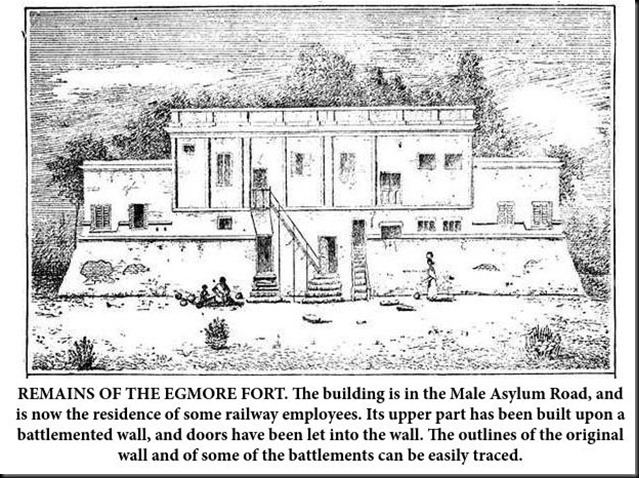Registered with the Registrar of Newspapers for India under R.N.I 53640/91
Vol. XXVIII No. 8, August 1-15, 2018
Lost Landmarks of Chennai
- SRIRAM V
The redoubt no more – not even in memory

The Gandhi-Irwin Bridge does not span a water body. It rises over the railway tracks leading to Egmore and the road that connects it at both ends shares its name. Gandhi thankfully remains well-known though it is unlikely many would remember the Viceroy who makes up the other half of the name. Less known would be the historic pact made in Delhi between the two that is commemorated by way of this road. Completely forgotten is its earlier name – Redoubt Road, for it connected to the Egmore Redoubt, a fortification that has completely vanished.
In its time it was quite a landmark. According to The Life of the Rev Andrew Bell, Prebendary of Westminster, by Robert and Charles C. Southey, the Redoubt was built in 1702. It was a square with a bungalow in the middle; a sergeant and sepoys occupying it, remaining on guard for any threats that could appear from the western side to Fort St. George. As per the Madras Tercentenary Volume, it was constructed “on a high level in the village, from which a clear prospect of Madras could be had and signals made for succour from the fort against an advancing enemy.”
Before the construction of the Redoubt, a choultry (native rest house) stood there. It was Governor Thomas Pitt who saw the value of the location and converted it into a guardhouse. In 1710, this foresight was vindicated when a set of soldiers stationed here managed to quell around 40 horsemen belonging to the Nawab. That set Governor William Fraser thinking and he formed a committee comprising the Paymaster, the Commanding Officer and the Chief Gunner to form plans for the setting up of a Redoubt. A guard room was recommended with the lower part entrenched and fortified with brickwork. The estimate was 925 pagodas. Governor Harrison and his council oversaw the execution that resulted in a cost of 5,060 pagodas with a further 1,500 being needed for completion. The Directors in England saw red and decreed that the difference between plan and actual ought to be met by Governor Fraser and his Council. There was, of course, no way of actually ensuring this and so Harrison had the Redoubt completed by spending an additional sum of 1,000
pagodas!
For some reason, the East India Company was of the view that this was a good place for sick soldiers, especially those recently arrived by ship from England, to recuperate in and so these were sent to it on a regular basis. In 1752, faced with consistently inferior gunpowder made at Fort St. David, Cuddalore, the Company decided to convert the Redoubt into a gunpowder factory. Remodelled at a cost of 7,500 pagodas, the facility was overseen by John de Roos, a German. Quality was suspect here too, and there was correspondence over it. From this we see quite a list of interesting ingredients going into the making of gunpowder – brandy, arrack, water, wine and urine! A Committee of Works was put in charge of the mill from 1756.
The siege of Madras in 1758 by the Comte de Lally had the French occupying the Redoubt. When they were forced to leave, de Lally ordered the blowing up of the mills and the Redoubt. On the lifting of the siege, the English put up a temporary shelter here to make gunpowder. A terrific explosion killed several and work began on a proper mill at the Redoubt. The mill was back in operation by 1762 only to have a cyclone whisk away its roof in 1768.
Further details emerge in the 1790s. From a minute of Major Maule dating to 1793, we know that the Redoubt had a drawbridge that was replaced that year.
By 1799, there was no further need for a Redoubt in Egmore. The building was handed over to the Madras Male Asylum. Glynn Barlow, in his Story of Madras, dating to 1921, records some of the changes that the Asylum made to the Redoubt – an upper storey comprising a row of windowed chambers that sat rather oddly on the buttressed and battlemented wall, windowless and grim. To him, the composite whole was a reminder of old-time war and latter day peace. It was from here that the Asylum Press Almanac was brought out for years before the Asylum moved to Poonamallee High Road and the press to Mount Road in 1900.
That year, the Directors of the Asylum sold the Redoubt to the South Indian Railway Company which was making Egmore its headquarters in Madras. The old Redoubt underwent many changes and became the quarters of railway employees, additional storeys being built to accommodate larger numbers. Writing in 1913, Col. Love in his Vestiges of Old Madras, describes what then survived of the Redoubt – “the external face wall along the western side, and about half that on the northern side, were utilised in the construction of buildings which still survive. The face wall was 6 feet high to the cordon and 3 ½ feet above, and the rampart, including both external and internal walls, was 12 feet thick. Twelve embrasures was visible in the portions preserved.”
All of these vanished when, with the nationalisation of the railways in 1951, fresh work began in the area. The Redoubt was pulled down. Today, a narrow pathway to the rear of Egmore station leads to the railway colony there. Much changed even in the last sixty years, it holds within it the original location of the Redoubt. But of the fort itself, there is not a trace. The Gandhi-Irwin Pact of 1931, hailed as a significant development in India’s freedom struggle, saw Redoubt Road being renamed as Gandhi-Irwin Road and with that the Redoubt passed, even in name, from collective memory.


Very nice.